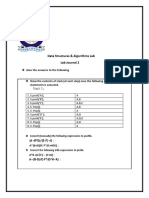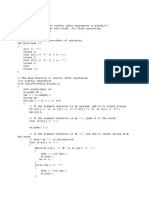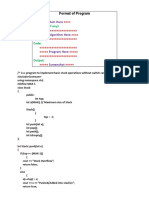0% found this document useful (0 votes)
76 views25 pagesIsalfa (X) To Check Whether Character X Is An Alphabet or Not Isdigit (X) To Check Whether Character X Is A Digit or Not
The document discusses various algorithms related to stacks and string manipulation. It includes:
1) Three ways to reverse a string in C++ using iterators, pointers and recursion with time complexity of O(n) and space complexity of O(1), O(n) respectively.
2) Algorithms to check for balanced brackets in an expression and minimum number of bracket reversals using a stack with time complexity of O(n).
3) Ways to find the next greater element for every element in an array and evaluate a postfix expression using a stack with time complexity of O(n).
Uploaded by
Avirup RayCopyright
© © All Rights Reserved
We take content rights seriously. If you suspect this is your content, claim it here.
Available Formats
Download as DOCX, PDF, TXT or read online on Scribd
0% found this document useful (0 votes)
76 views25 pagesIsalfa (X) To Check Whether Character X Is An Alphabet or Not Isdigit (X) To Check Whether Character X Is A Digit or Not
The document discusses various algorithms related to stacks and string manipulation. It includes:
1) Three ways to reverse a string in C++ using iterators, pointers and recursion with time complexity of O(n) and space complexity of O(1), O(n) respectively.
2) Algorithms to check for balanced brackets in an expression and minimum number of bracket reversals using a stack with time complexity of O(n).
3) Ways to find the next greater element for every element in an array and evaluate a postfix expression using a stack with time complexity of O(n).
Uploaded by
Avirup RayCopyright
© © All Rights Reserved
We take content rights seriously. If you suspect this is your content, claim it here.
Available Formats
Download as DOCX, PDF, TXT or read online on Scribd
/ 25





































































































